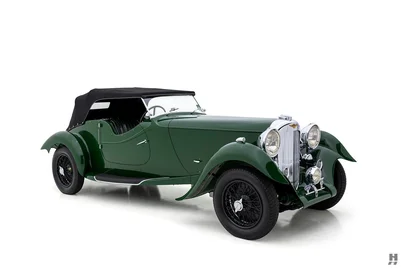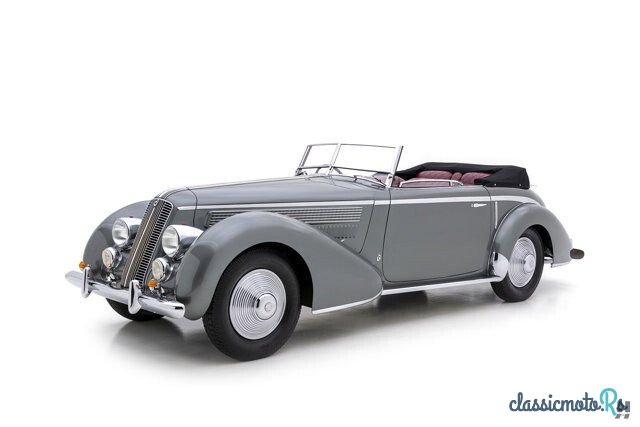
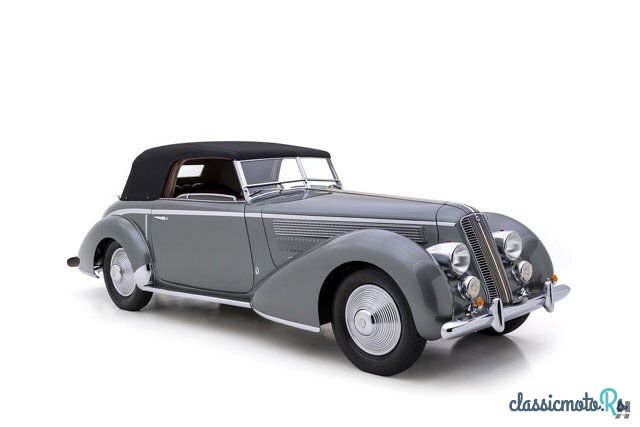
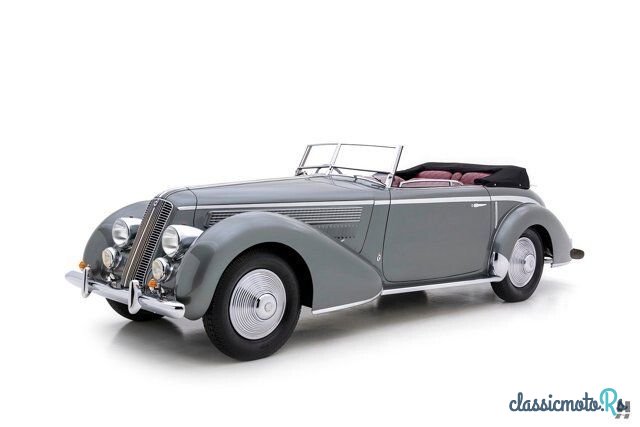
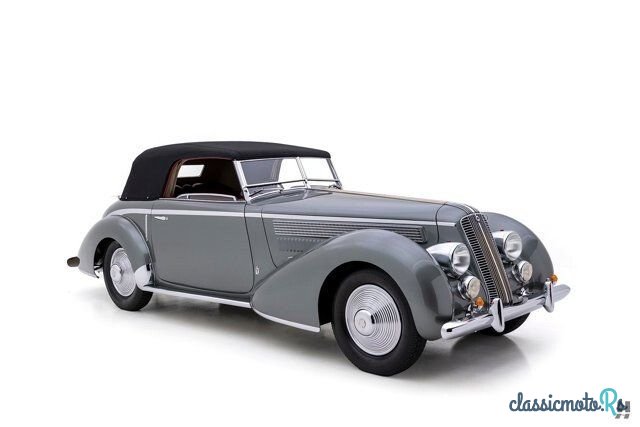
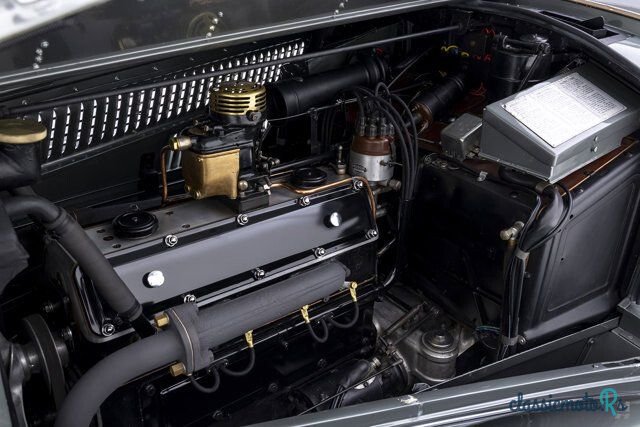
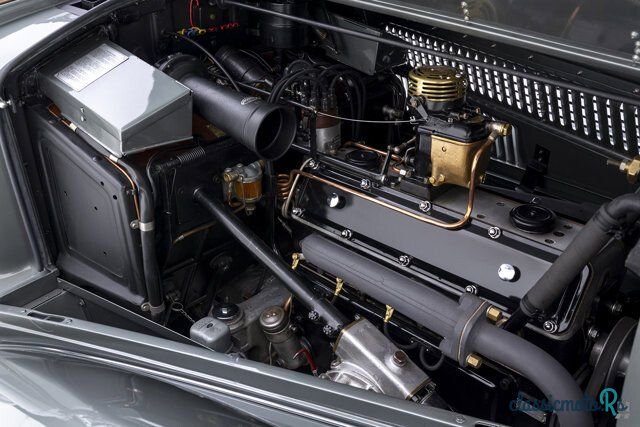
6 photos
1936' Lancia Astura
Report This Ad!Rate This!Bookmark This
$985,000Published 12 April 2025ID: 634ES1
Expired
8 months ago
8 months ago
Information from the owner
Body: Convertible
Age: 89 years
Electronics: AM/FM Radio
Seller's comments about 1936' Lancia Astura
The Lancia Astura stands as one of the most refined and technologically advanced automobiles of the pre-war era a testament to the marques relentless pursuit of innovation engineering excellence and craftsmanship. Introduced in 1931 the Astura continued Lancias tradition of cutting-edge design featuring a sophisticated narrow-angle V-8 engine and independent front suspension with self-lubricating sliding pillars-an advanced system that provided a remarkably smooth and controlled ride. The third-series Astura debuted in 1933 with an enlarged 2.9-liter engine producing 82 horsepower delivering improved torque and refinement over earlier models. Top speed was more than 80 mph with handling roadholding and brakes to match. For the first time the Astura was offered in two wheelbase lengths: the long-wheelbase Tipo 233L (131 inches) and the shorter more sporting Tipo 233C (122 inches) with 908 and 328 examples built respectively.While the Asturas engineering was state-of-the-art many left the factory wearing relatively conservative coachwork. Those seeking something more distinctive turned to Italys finest coachbuilders with Carrozzeria Pinin Farina emerging as the undisputed master of crafting striking bespoke bodies for the Asturas advanced underpinnings. One of the most celebrated designs to grace the Astura chassis was the Tipo Bocca cabriolet named for Vittorio Bocca a prominent Lancia dealer in northern Italy who commissioned six such examples three on the long-wheelbase chassis and three on the short-chassis. Designed by the highly regarded stylist Mario Revelli di Beaumont the Bocca cabriolets were among the most advanced and luxurious open cars of their time. Their streamlined proportions emphasized horizontal lines lending an unmistakable presence that was both elegant and sporting. The dramatic waterfall grille delicate chrome detailing and a fold-flat windscreen provided a modern aesthetic while a power-operated convertible top-an extremely rare feature in the 1930s-further elevated the designs technical sophistication.According to the Lancia Classiche Certificate of Origin chassis number 33-5301 was completed on June 30 1936 and delivered as a bare chassis to Pinin Farina. There it was clothed in its exquisite Tipo Bocca cabriolet bodywork a masterpiece of pre-war Italian coachbuilding. While each Bocca cabriolet featured unique details this example retains defining characteristics such as its elegantly curved side windows chrome side molding that visually lengthens the body and finely detailed bonnet-side vents. Research conducted by respected Lancia historian Wim Oude Weernink suggests that this exampleis unique among the six Bocca-bodied Asturas as it was never road-registered but was instead displayed at the 1937 Berlin Motor Show. A period Pinin Farina advertisement in Motor Italia indicates that the car originally featured a striking two-tone exterior adding to its presence on the show stand. Further supporting its early German history the Lancia retains a dashboard-mounted Telefunken radio-an unusual feature that aligns with a 1970s article in the American Lancia Club journal which claimed the car had been originally delivered and fitted with a radio by German Lancia dealer E. Uebel in 1937. While its original engine is no longer present the car is equipped with a correct replacement 2.9-liter Lancia Astura Series IV V-8 maintaining its authenticity and mechanical integrity.By the late 1950s the Astura had made its way to the United States where period photographs document its presence in New York. Though it appeared largely complete at the time the cars condition continued to decline over the following decades. In 1982 salvation arrived when a Swiss collector with a deep appreciation for Lancias engineering and design rescued chassis 33-5301 from neglect. He embarked on an exhaustive multi-decade restoration that would ultimately span nearly 40 years utilizing some of Switzerlands finest craftsmen to return the car to its original grandeur. During this process the Pinin Farina bodywork was carefully restored and finished in a refined anthracite metallic a color that perfectly complements its striking form. Inside the intricate intrecciato pattern basket-weave upholstery was faithfully recreated in rich oxblood leather a distinctive and period-correct detail that was visible in historic photographs of the car.Today this Lancia Astura Bocca cabriolet stands as an extraordinary example of pre-war Italian design engineering and craftsmanship. It joins an elite group of surviving Bocca-bodied Asturas one of which was awarded Best of Show at the prestigious Pebble Beach Concours dElegance in 2016 the only Lancia ever to receive that honor. This underscores not only the models significance but also the esteem in which the Astura is held among collectors and historians. Under the care of its most recent custodian a dedicated Lancista this Astura has received extensive post-restoration fine-tuning by renowned specialists at Jonathan Wood Restorations including an overhaul of the front suspension brakes and instrumentation. The car remains in exceptional condition retaining its proper Marchal lighting period-correct trim and a host of exquisitely detailedcomponents that reflect its meticulous restoration.This exceptional Lancia presents a rare opportunity to acquire one of the most celebrated pre-war automobiles ever produced. With its breathtaking Pinin Farina styling advanced engineering and unparalleled provenance it is poised to be a highlight at the worlds foremost concours events. As a true confluence of technical innovation and aesthetic brilliance this Astura Bocca cabriolet represents the pinnacle of Lancias golden era and remains an enduring symbol of elegance and exclusivity. Offers welcome and trades consideredFor additional details please view this listing directly on our website https://hymanltd.com/vehicles/7837-1936-lancia-astura-cabriolet/
